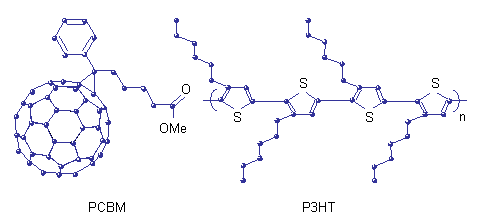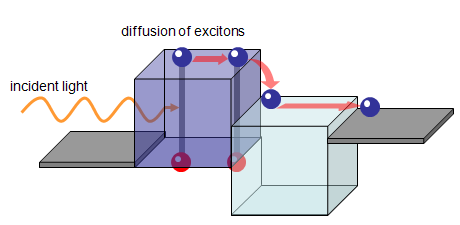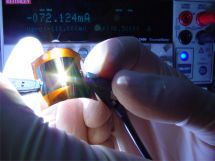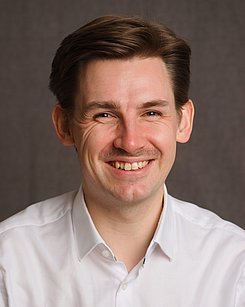Organic Photovoltaics

Typical donor and acceptor materials for OPV
The chair of Electronic Devices is active in the research field of organic photovoltaics. The processing of the devices and the resulting material properties and characteristics are investigated aiming the optimal device performance. Challenging such issues, the fundamental processes taking place in organic solar cells are crucially important to understand. That is why this interdisciplinary research field unites the physicists, chemists and electrical engineers.

Schematical illustration of carrier transport in plastic solar cell.
The electronic, optical as well as thermo-dynamical properties of organic semiconductors are tuned during directed chemical synthesis of these materials.

Schematical image of the printed plastic solar cell.
There are several advantages of organic photovoltaics compared to conventional Si-technology that make it so special. The organic materials and solar cells can be handled without using vacuum deposition processing that limits the solar module area, but by printing the active and functional materials continuously and cost-effective.

OPV on a flexible substrate
Very soon the semitransparent organic solar cells may equip each and every window in the world. Very small quantities of materials are required for the production of OPV devices, as the extinction coefficients of these materials are typically very high.
Realization of flexible solar modules is also possible, as the mechanical stress by bending the thin layers of the device is low. Thin layers result also in a very light weight of the OPV module, which means a variety of mobile applications (house independent energy source for notebooks, phones and other small consumers, automotive applications, air transportation etc.). A plenty of other interesting application forms in different branches of human activity can be realized by implementing this technology.
Publications:
- D. Di Carlo Rasi, P. M. J. G. van Thiel, H. Bin, K. H. Hendriks, G. H. L. Heintges, M. M. Wienk, T. Becker, Y. Li, T. Riedl and R. A. J. Janssen:Solution-Processed Tin Oxide-PEDOT:PSS Interconnecting Layers for Efficient Inverted and Conventional Tandem Polymer Solar CellsSolarRRL 3, 1800366 (2019).
- T. Becker, T. Gahlmann, N. Köhler, F. Zimmermann, F. Göbelsmann, K. O. Brinkmann, and T. Riedl:Suppressing the photo-induced degradation of inverted non-fullerene organic solar cellsMRSFall Meeting, Boston (USA), EP05.03.50 (2018).
- T. Becker, S. Trost, A. Behrendt, I. Shutsko, A. Polywka, P. Görrn, P. Reckers, C. Das, T. Mayer, D. Di Carlo Rasi, K. H. Hendriks, M. M. Wienk, R. A. J. Janssen, and T. Riedl:All-Oxide MoOx/SnOx Charge Recombination Interconnects for Inverted Organic Tandem Solar CellsAdv. Energy Mater. 8, 1702533 (2018).
- T. Riedl:Metal Oxide-Based Charge Extraction and Recombination Layers for Organic Solar CellsIn: The Future of Semiconductor Oxides in Next-Generation Solar Cells, Elsevier, p. 159-181 (2018).
- T. Becker, P. Reckers, C. Das, T. Mayer, M. F. Oszajca, N. A. Luechinger, W. Li, M. M. Wienk, R. A. J. Janssen and T. Riedl:Room temperature solution processed all-oxide interconnects for inverted organic tandem solar cellsICMAT, Singapore (SGP), C2-10 (2017)
- S. Trost, T. Becker, A. Polywka, P. Görrn, M. F. Oszajca, N. A. Luechinger, D. Rogalla, M. Weidner, P. Reckers, T. Mayer, and T. Riedl:Avoiding photo-induced shunts in organic solar cells by the use of tin oxide (SnOx) as electron extraction material instead of ZnOAdv. Energy Mater. 6, 1600347 (2016).


